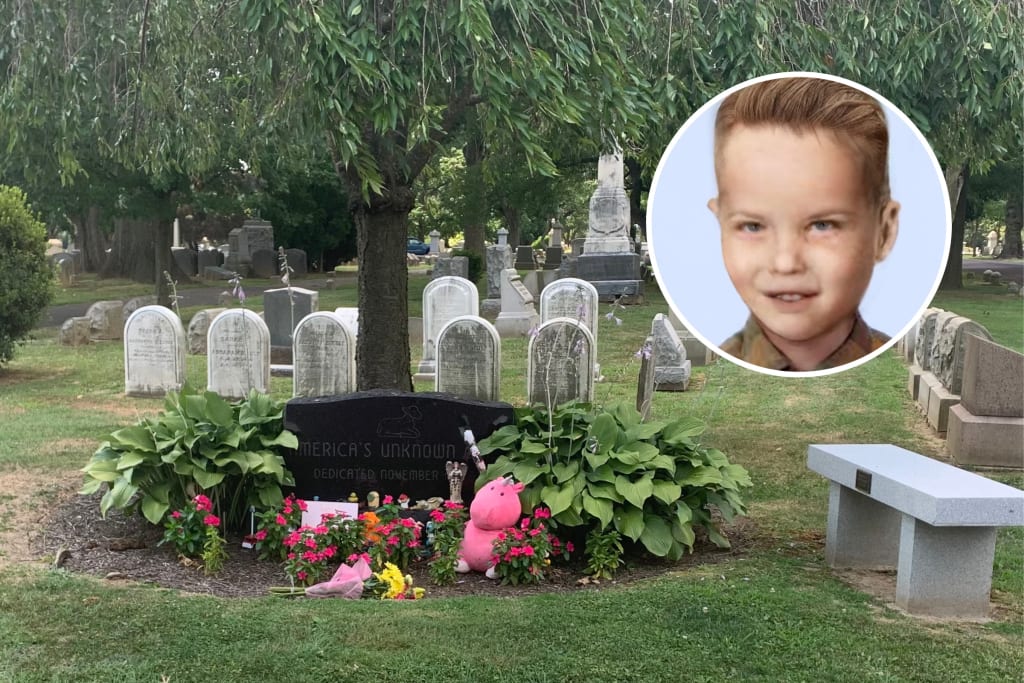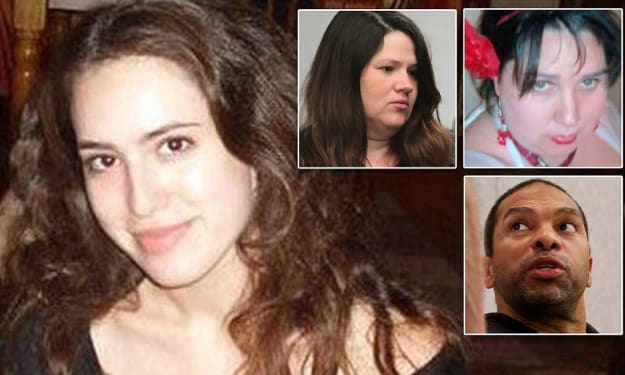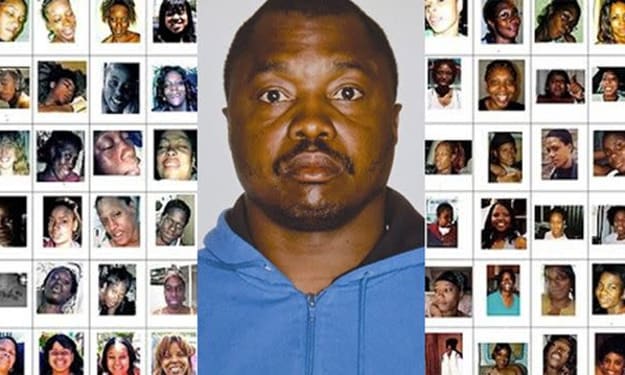
THE BOY IN THE BOX— JOSEPH AUGUSTUS ZARELLI
America’s Unknown Child
A True Crime publication by Carly Junod
I’ve been a true crime fanatic basically from the moment I had access to the internet, so probably mid elementary school age. This specific case has always been a heart wrenches for me, and today I get to share the harrowing details that finally lead to the first solid break in the case.
After 65 years of investigation, The Boy In The Box— or America’s unknown child finally has a name: Joseph Augustus Zarelli.
Born January 13, 1953 and found deceased on February 25, 1957, the case of the formerly unidentified toddler has gripped the hearts of our nation for over six decades. While many theories have surfaced and since been debunked, progress in DNA testing has finally put a name to the precious yet haunting face that has appeared on posters, milk cartons, electric bills, and most recently true crime TikTok pages over the years. Now that Zarelli has been identified, which of those theories are still credible, and which new theories can be formed based on evidence?
The previous John Doe was found in a cardboard box off of Susquehanna Road in the Fox Chase section of Philadelphia, Pennsylvania. The cardboard box previously held a baby bassinet from JC Penney’s.
The boy was nude, covered in bruises from both old and recent beatings and also showed signs of extreme malnourishment. Despite the extensive signs of abuse, the child was actually very clean, and even had his nails and hair cut recently. Clumps of hair on and around his body indicated that his hair might’ve even been cut post mortem.
The official cause of death was ruled to be blunt force trauma. He had scars from both abuse and surgeries. An autopsy of the body ruled that the Boy in the Box had been dead up to two or three days before being reported.
Notice how I say reported, and not discovered. He was first discovered on February 25 by a man checking muskrat traps who decided it was best to keep his findings to himself, seeing that his traps were illegal and he didn’t want any trouble with the police. If that’s not ridiculous enough, it not only happened once, but twice! Days later, a college student saw a rabbit run into the area and decided to check the traps there in case the rabbit was stuck, and he, too, found the Boy in the Box. It took a whole day for him to speak up about it, only after hearing about missing girl Mary Jane Barker, who disappeared days earlier and was the same approximate size and age of Zarelli.
I will never understand why horrible crimes like this go unreported for so long. I hope it’s not just me, but I’ve got a bleeding heart that just cannot keep those kinds of things to myself. Especially seeing that it’s a child we’re talking about. I think that’s what caught America’s attention more than anything else about this case. Bodies go unidentified all the time. People get murdered every single day. What I think made Zarelli so special to the media was that since he had no identity and had been treated in such a horrific way, it made the public think of their own sons, grandsons, and students. He quite literally could have been anyone’s baby. Looking at his photo makes me think of my own brother who is three years old. It makes me want to just squeeze him tight and let him know that he’s loved, like I hope somebody loved Zarelli during his tragic, short life.
This was long before the time of DNA testing, so authorities opted for posting pictures of Zarelli across all platforms in hopes that someone would recognize him. Photos of him already deceased, as well as forensic sketches of what he might’ve looked alive and healthy were distributed onto newspapers, posters, milk cartons, electric bills, and just about any other possible medium.
With how massive the case became, it was a wonder that no family ever stepped up to claim him. With surgery scars, one would think a doctor would recognize him, especially if they operated on him themselves. Surely a pastor, family friend, or neighbor could’ve recognized him, right?
With the idea that he could truly be anyone’s child came an abundance of theories. One relevant theory was that he came from a foster home 1.5 miles from where his body was found. In 1960, a tip from a psychic to the medical examiner’s office led to an investigation into the foster home. Ran by a man and his daughter— well, some reports say it’s his daughter. Other reports say that she is his foster daughter that he later married when this theory was revisited years later?
Anyway, on the grounds of the foster home, there were several blankets on clotheslines similar to the one found wrapped around the boy in the box. Both the blanket in evidence and the blankets on the clothesline were homemade with traditional Native American patterns. While that can often be just a common coincidence, the JC Penney’s bassinet upstairs told a different story. However, there was no serial number or receipt to prove that the box belonged to the bassinet. One thing they could learn from it is that only eleven bassinets were sold. Nine of the people were contacted and “ruled out as suspects” but the other two buyers were never located.
What I find interesting about them ruling out the bassinet buyers as suspects is that the bassinet box was the closest thing to an actual clue that the Philadelphia PD had. Whoever put that boy in the bassinet box had some connection with those eleven people. Seeing the location of the foster home in comparison to the site where the body was found and the homemade Native American blankets, you’d think that’d be more than enough to investigate the foster home further.
Perhaps the child died at the hands of the foster father, or maybe it was accidental? Beyond circumstantial evidence, there was no concrete proof to show that the foster home was in any-way involved. So, that lead that seemed so promising was tossed aside by police. However, it stayed fresh in the mind of medical examiner Remington Bristow. It stayed fresh for over thirty-six years.
Renowned for his work on over 100 unidentified victims throughout his career, the boy in the box became Bristow’s number one focus; so much so that he kept a death mask of the child in his briefcase at all times. Three years after the boy was found, Bristow revisited the foster family lead.
After interviewing the foster family, reviewing old police interviews, and even contacting children who once lived in the home, it seemed that all coincidental signs pointed to this family. The couple eventually moved and held an estate sale in 1961, where Bristow saw the bassinet himself. He theorized that perhaps the boy in the box was the child of an unwed daughter of the foster home, who might’ve dumped the body to avoid being exposed as a single mother.
In 1993, after 36 years of working on the case, Remington Bristow passed away at the age of 72. He never retired from the case of the boy in the box. Family members and coworkers described his relationship with the unknown child as though it were his own son. His dedication to the boy is arguably the reason that he has finally been given an identity since he made sure no one forgot about him.
The case was temporarily closed until 1998 when the Philadelphia PD appointed detective Augustine to the unknown child and he picked up right where Bristow left off. In hopes of matching the DNA of the foster home daughter to that of the boy in the box, he tracked down the head of the foster home: Arthur Nicoletti.
While the foster home was running, Arthur was married to Catherine Nicoletti, who had a daughter named Anna Marie Nagle from Catherine’s previous marriage. Anna has been theorized to have had chronic mental illnesses that prevented her from living independently. Further investigation revealed that Anna had indeed had not only one but four children out of wedlock. When asked if one had died around 1957, she confirmed that one had passed away in a tragic accident involving electrocution in an amusement park. A coroner’s report and death certificate backed up the claim.
If you remember from earlier in this episode, there was some confusion about Nicoletti and his wife. At this point in time in the investigation, years after Detective Bristow’s death, Catherine had passed away, and Arthur had taken her daughter, Anna, as his wife. This fact further pushed the theory that the boy in the box was Anna’s child, and that Arthur may have even been the father.
DNA testing eventually proved that there was no match between Anna and the child John Doe, but personally, I don’t think that should have ruled them out as suspects. Remember that this family ran a foster home. When they were first questioned, they had eight children in their care. Neighbors and friends shared with authorities that at any given time, the family had between five and twenty-five children living in their home. The possibility that one of the children passed away from either murder or even an accident is too great for me to ignore, personally. Seeing that one of Anna’s biological children had passed away in such a horrid way, what kept any of the foster kids from facing the same fate due to neglect?
Foster homes that take in children on the scale that the Nicoletti’s did are often made only for the sole purpose of easy income. In their eyes, if the government pays for them to house these children and don’t do much to regulate the living conditions, why not take in as many children as possible to keep generating money? The murder took place during the 1950s, a time notorious today for an influx in domestic violence and a much looser grip on the law. There was certainly no CPS or DHS to constantly be regulating and investigating foster homes when suspicions arose.
Despite the mounting circumstantial evidence, not even Detective Augustine was able to investigate further due to the negative DNA results. So, we move on to another prominent theory.
Fast-forward to 2002. An unlikely event takes place: a confession. A woman who preferred to be named only “Martha” came forward claiming that her abusive mother had purchased the boy in the box from his birth parents in 1954, naming him Johnathan. He was then subjected to abuse on various levels such as physical, and even more unfortunate, sexual abuse.
While many confessions similar to this took place, the reason that Martha stood out from others was that she knew sensitive information to the case that was never released to the public. Martha shared with authorities that during dinner one evening, Johnathan was eating a plate of baked beans when he became sick and vomited them up. Out of frustration, Martha’s parents began to beat Johnathan into unconsciousness. He was promptly placed in a bathtub where he allegedly never woke up.
Unbeknownst to the public, the coroner’s report showed that the boy’s last meal was baked beans, and that his fingers were water-wrinkled antemortem.
Antemortem: before death.
Perimortem: during time of death.
Postmortem: after death.
Martha’s story was never debunked, though authorities were never able to back it up due to her having a history of mental illness. Neighbors were also unable to verify her story and deemed her claims “ridiculous.”
Before any more investigating into Martha’s lead could be performed, her real identity and personal information was leaked to the public. “Martha” disappeared from public eye and refused to comply with law enforcement any further.
While many other theories circulated throughout the years of the investigation, such as the boy being the child of traveling circus performers, and the theory that he may have been raised as a girl, none held any footing after they were investigated. For the most part, the case died out again.
But, no one gave up. In 2019, the Boy in the Box was exhumed from the potter’s grave he was originally buried in hopes of extracting a new DNA sample. Using DNA from one of his teeth, they were able to develop a mitochondrial DNA profile.
There are several types of DNA typing depending on the quality of the sample. For example, Short Tandem Repeat, or STR Analysis, is the analysis of specific regions found on nuclear DNA. This is where regions of multiple samples are compared for similarities.
But this is mitochondrial DNA. The difference between mitochondrial and nuclear is important, especially in this case. Nuclear DNA can be compared to any blood relatives of a person to determine relation. For example, in the Christmas movie, “Elf,” Buddy gets a DNA test to prove that Walter Hobbs was his biological father.
Mitochondrial DNA, however, applies only to maternal DNA. It is inherited from a single female lineage, so it could be applied to identify a mother, grandmother, anybody on the mother’s side of the family. When the DNA was first sampled in 2019, there were no results.
Now we backtrack just a little bit to 2017. Introduce Justin Thomas. Thomas isn’t an investigator, a medical examiner, a suspect, nothing like that. Justin Thomas was just a guy looking for a good Christmas gift for his girlfriend… and he ended up buying her a DNA kit.
Unfortunate for Thomas, the relationship would dissipate before Christmas, but fortunately for the boy in the box, he decided to use the test himself. I’ll now read an excerpt from an article on Newsbreak.com, written by journalist Nikki Young. She goes in detail about not only the Boy in the Box, but also other major cases such as the recent Idaho murders. I strongly suggest checking out her articles and showing her some support for her investigative journalism.
“Thomas discovered that many of his distant relatives hailed from Italy and he still he had many living family members still there. The information was neat to know. He was able to fill in his family tree a bit and he didn’t really give it any more thought than that. Until he received a phone call from a forensic genealogist and cold case liaison who was asking for his help. The woman on the other end of the line, Misty Gillis, told him that he was a match for a cold case but, in order to help identify the victim, they would need some more DNA from his family. Thomas agreed to help and was able to obtain a sample from this mother. Again, he didn’t think any more of it - other than he was happy to be able to help.”
Personally, I believe that Misty Gillis is the Remington Bristow of this generation in forensics and law enforcement. She is a forensic/genetic genealogist who had access to DNA results from at-home genealogy kits that had been given permission to be shared with law enforcement. When kits are purchased, most companies allow the customer to choose whether or not their information may be shared. Since Justin Thomas allowed it to be shared, Misty Gillis worked hard to find a DNA match, and succeeded. After Thomas’s mother provided a sample, it was revealed that the boy in the box was her first cousin. Namely, a first cousin she had never heard about.
Also using genetic genealogy, Gillis was then able to track down a paternal sample from a third or fourth cousin. The sample was nowhere near as close as Thomas’s, but it was effective. Both parents were identified. Mother, Mary Elizabeth (Betsy) Abel. Father, Augustus (Gus) Zarelli.
But, both parents are now deceased. Living siblings on both sides have been identified, but law enforcement isn’t releasing their names at this time for the sake of their privacy.
Though the boy in the box, four-year-old Joseph Augustus Zarelli, now has a name, his story is nowhere near over. Information obtained since his identification only raises more questions and more theories, and more information that this internet super sleuth was able to obtain thanks to days and days of internet rabbit holes… of which I will dive deeper into in my next publication. Thank you for reading.
If you have any information about this case or any other cases involving children, I urge you to contact The National Center for Missing and Exploited Children.
https://www.inquirer.com/news/philadelphia/boy-in-the-box-philadelphia-case-backstory-20221207.html
https://www.inquirer.com/crime/philadelphia-boy-box-girl-box-forgotten-20221209.html
https://pentucketnews.com/11848/featurearticle/the-unsolved-case-of-the-boy-in-the-box/
https://www.newsweek.com/boy-box-identity-revealed-philadelphia-pennsylvania-theories-latest-update-1764690
https://edition.cnn.com/2002/LAW/12/05/ctv.traces.boy.box/index.html
https://undsci.berkeley.edu/teach-resources/nuclear-vs-mitochondrial-dna/
https://www.dailymail.co.uk/news/article-11696709/Inside-65-year-hunt-identify-Philadelphias-Boy-Box-cold-case-murder-victim.html
About the Creator
Carly Junod
Just a university student with many passions. Above all of them: writing. I won my first creative writing award through the state of Oklahoma in 7th grade, and I haven't looked back since. A girl who wants the best of life and literature.
Enjoyed the story? Support the Creator.
Subscribe for free to receive all their stories in your feed. You could also pledge your support or give them a one-off tip, letting them know you appreciate their work.






Comments (1)
Extremely miserable.